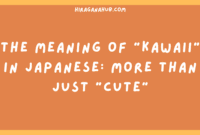The first time I heard “You’re welcome” in Japanese, I was expecting a single,
universal phrase like in English. But nope, Japanese doesn’t work that way. I
learned that there are several ways to say it, depending on the situation,
level of politeness, and even regional differences. And let me tell you, I
made my fair share of awkward mistakes while trying to figure it all out!
The Classic ‘Dou Itashimashite’ (どういたしまして)
Let’s start with the phrase most people learn first:
どういたしまして (Dou itashimashite). This is the textbook
translation of “You’re welcome.” It’s polite and proper, but here’s the
thing—Japanese people don’t use it as often as we might think.
I remember using “Dou itashimashite” every time someone said
ありがとう (Arigatou) or
ありがとうございます (Arigatou gozaimasu) to me. But then I
noticed something: native speakers rarely responded that way! Instead, they’d
smile, nod, or say something completely different.
So, what do Japanese people actually say?
More Natural Ways to Say ‘You’re Welcome’ in Japanese
1. ‘Ie Ie’ (いえいえ) – The Casual, Everyday Response
If you ever listen to casual conversations, you’ll hear
いえいえ (Ie ie) a lot. It literally means “No, no,” and it’s
often used in place of “You’re welcome.”
Example:
- A: ありがとう!(Arigatou!) – Thanks!
- B: いえいえ!(Ie ie!) – No problem!
It’s like saying “No worries” or “Don’t mention it.” It’s super natural, and
honestly, I started using this way more than “Dou itashimashite.”
2. ‘Tondemonai’ (とんでもない) – A Humble Denial
This one confused me at first.
とんでもない (Tondemonai) means something like “No way” or
“Unthinkable.” It’s used when you want to humbly downplay the need for
gratitude.
Example:
- A: 本当にありがとうございます!(Hontou ni arigatou
gozaimasu!) – Thank you so much! - B: とんでもないです!(Tondemonai desu!) – No, no, not at
all!
It’s commonly used in customer service, workplaces, or formal settings. If you
want to sound extra polite, add です (desu) at the end:
とんでもないです!
3. ‘Daijoubu Desu’ (大丈夫です) – It’s Okay!
In some situations, people respond with
大丈夫です (Daijoubu desu), which literally means “It’s okay”
or “No problem.”
Example:
- A: ごめんなさい、助けてもらって… (Gomen nasai, tasukete
moratte…) – Sorry for making you help me… - B: 大丈夫です!(Daijoubu desu!) – It’s all good!
I first heard this from a Japanese friend after thanking them for helping me
carry something. At first, I thought they were saying “It’s fine” instead of
“You’re welcome,” but then I realized it’s just another natural way to
acknowledge gratitude.
4. ‘Kochira Koso’ (こちらこそ) – No, Thank You!
Sometimes, instead of saying “You’re welcome,” Japanese people flip the
gratitude back with こちらこそ (Kochira koso), which means
“No, thank you!”
Example:
- A: お手伝いしてくれてありがとうございます!(Otetsudai
shite kurete arigatou gozaimasu!) – Thank you for helping me! - B: こちらこそ、楽しかったです!(Kochira koso,
tanoshikatta desu!) – No, thank you! It was fun!
I love this phrase because it makes conversations feel warmer and more
reciprocal.
Common Mistakes to Avoid
- Using ‘Dou itashimashite’ all the time: It’s not wrong,
but it can sound a bit stiff or overly formal in casual situations. - Forgetting to nod or smile: Sometimes, just a nod or a
simple “Un!” (うん) works better than words. - Using the wrong level of politeness: If someone thanks
you in a very formal way, don’t respond too casually (and vice versa).
Saying “You’re welcome” in Japanese is more nuanced than I expected. At first,
I stuck to “Dou itashimashite,” but after observing native speakers, I
adjusted my responses. Now, I mix it up—”Ie ie” with friends, “Tondemonai
desu” in formal situations, and “Kochira koso” when I want to express
gratitude back.
If you’re learning Japanese, I recommend paying attention to how native
speakers respond to “Arigatou” in different situations. Trust me, it’s one of
those small things that makes your Japanese sound way more natural!



